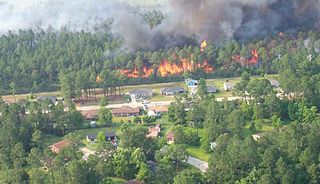This scientific paper published on the PNAS website discusses how carbon sediment from forest fires looks set to cause increased melting of the Greenland ice sheet over the next century. As stated in the abstract:

Forest fires, which are expected to become more frequent due to climate change, are speeding up melting of the Greenland ice sheet, which threatens to raise sea levels.
(Image credit)
In July 2012, over 97% of the Greenland Ice Sheet experienced surface melt, the first widespread melt during the era of satellite remote sensing. Analysis of six Greenland shallow firn cores from the dry snow region confirms that the most recent prior widespread melt occurred in 1889. A firn core from the center of the ice sheet demonstrated that exceptionally warm temperatures combined with black carbon sediments from Northern Hemisphere forest fires reduced albedo below a critical threshold in the dry snow region, and caused the melting events in both 1889 and 2012. We use these data to project the frequency of widespread melt into the year 2100. Since Arctic temperatures and the frequency of forest fires are both expected to rise with climate change, our results suggest that widespread melt events on the Greenland Ice Sheet may begin to occur almost annually by the end of century. These events are likely to alter the surface mass balance of the ice sheet, leaving the surface susceptible to further melting.
To read more about the changing world and what you can do to prepare, visit: www.greatwavesofchange.org

Read The Flooded Earth for the implications. http://www.amazon.com/The-Flooded-Earth-Future-Without/dp/B004NSVFOA